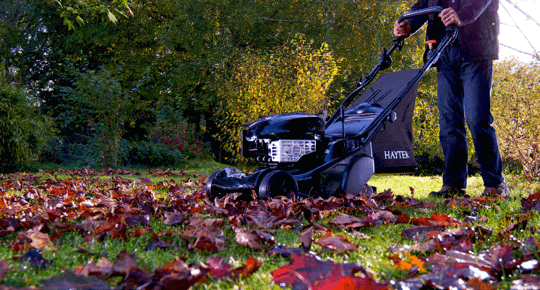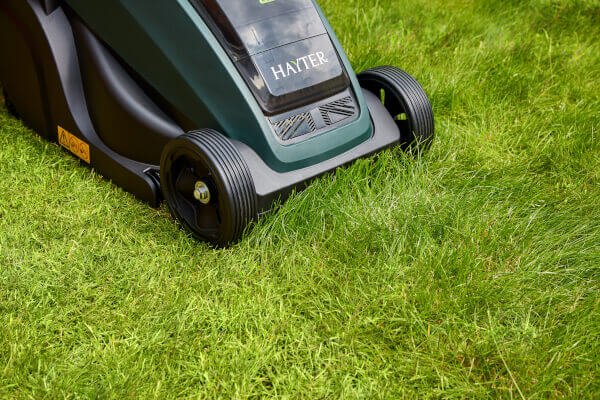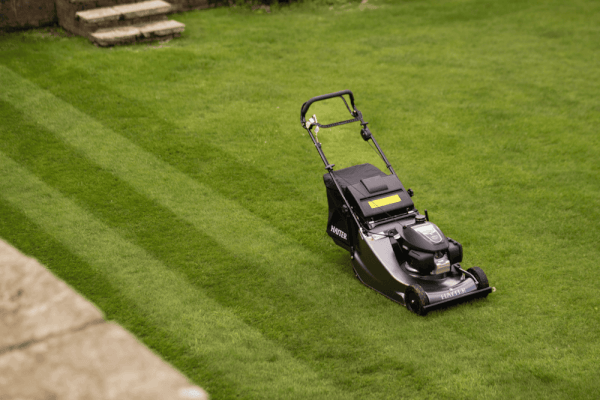
Here at Hayter®, we want everyone to feel confident that they can mow beautiful lawns every time. That’s why we’ve put together a comprehensive guide, so you can give your lawn the perfect look – no matter the condition or season.
When should you mow your grass?
Spring
Spring is the start of the cutting season! Usually, April is when gardeners bring their mowers out of winter hibernation to treat our lawns to beautiful stripes once again – but hot weather in March could bring this date forward. Thanks to increased light and stronger growth, you should be aiming to mow your lawn every two weeks during spring, shortening to every 10 days, and then finally mowing weekly as the weather gets warmer and we inch towards summer.
Weekly mowing will commence from around mid-May to June. This is also the time when you should be lowering the cutting height of your Hayter mower. Remember to never cut more than a third of your grass height! Doing this will promote healthy growth into the summer months.
In late April or May (when the weather is consistently above 10°), you can scarify your lawn, followed by fertilisation and feeding. This will help the soil recover from the harsh winter months.
If you find it’s an especially rainy spring, don’t mow on days when the grass is very wet. Mow when the grass is dry or at least slightly damp, and if you must mow in wetter conditions, raise the cutting height of your mower before you cut – you can then return to the lawn in a couple of days at a lower height when the grass is drier.
If spring showers are a consistent problem, you can aerate the soil by creating holes 4-6 inches deep, helping water drainage. These holes will allow the water to flow underground, rather than pool on the surface of the soil.
Summer
In the summer months, follow the same mowing practices as towards the end of spring – weekly mows, being careful not to remove more than a third of the grass height. Avoid over-fertilising, especially if your lawn is looking dry and patchy, as this can lead to scorched grass, burnt roots, and altered soil pH.Summer is more prone to dryness than winter, especially with the intense heat waves in recent years. If there is a drought, water more frequently and cut back on mowing frequency to every two weeks, like at the beginning of spring. Raising the cutting height will also help give your grass more time to grow without damaging the grass further.
Use a sprinkler system if possible to ensure even distribution of water. However, if you’re living in a region with a hosepipe ban, this won’t be an option – in that case, you’ll need to hold off and hope for rain.
Autumn
Autumn is the beginning of the end of the mowing season, but there’s still a good amount of time to mow under the right conditions.Mow as you did throughout summer up until the beginning of November, cleaning up your garden's borders from leaves and debris as you go.
Autumn is the ideal time of year to scarify your lawn once more, as the weather conditions are typically mild with moist soil. Scarifying at this time will improve airflow to your lawn, encourage the last of the growth before winter, and leave your grass stronger as the cutting season ends.
After scarifying, aerate and feed your soil to leave it in the best possible condition before winter, as the fertiliser will remain in the soil, feeding your lawn all winter long.
Winter
Winter is when to stop mowing your grass, but November will be the last month of mowing before the cutting season comes fully to an end until next spring.Raise the cutting height of your mower so the blades are at the highest possible point. Grass will grow much slower in winter, so it’s best to leave it a bit longer so it stays strong and healthy, ready for spring.
If the weather is icy or especially cold, don’t mow the grass. Instead, wait for cool conditions when the sun is at its highest – ideally around midday when it’s a bit warmer.

How to cut grass
Depending on your mower's fuel type, start by either filling your mower with unleaded petrol or fully charging your mower’s battery. If you have yet to purchase your Hayter mower, check which fuel type is best for your garden and personal preferences.Next, check that the weather conditions are suitable for the time of year and clear your lawn of any debris if necessary – this includes leaves, twigs and even dog toys or children’s play equipment. If your lawn is especially leafy, you may want to use the Electric Battery Leaf Blower 60V Flex Force Power System® by Toro® to blow leaves away quickly.
Once ready to go, begin at the border of your lawn and make your way inwards from one side to the other – keeping your cutting height to the ideal settings for the time of year. You should never cut more than one-third of your grass length, even in summer.
As you mow, be sure to keep to straight lines for a uniform finish.
Cutting the perfect lawn stripes
For cutting the perfect lawn stripes, start at a right angle to your garden’s perimeter and mow up to the edge of your garden.
When you reach the end of your first line, turn 180° and mow back onto the next adjacent line the opposite way.
Make sure to overlap the lines very slightly as you go. This will prevent any patchiness as you turn.
Once you get the hang of traditional lawn stripes, you’re free to experiment with plenty of different stripe designs! From curvy to tartan, crisscross and more – the only limit is your imagination.
We share the best submitted lawn stripe designs on our socials, so be sure to follow the Hayter Facebook and Instagram for inspiration!
For a more in-depth striping tutorial, read our full How to Stripe Your Lawn guide.
How to cut the edges of grass
You should always start at the border of your lawn when mowing, but for those pesky bits on the edge, it’s best to use Toro’s Battery String Trimmer 60V. This will help you get into the nooks and crannies of the grass border easily, without having to mow over the same area multiple times. This is especially useful if your lawn isn’t completely flat.
Similarly, if your lawn is bordered by bushes, use Toro’s Cordless Hedge Trimmer 60V to cut back encroaching foliage.
Using a strimmer: how to strim grass
Using a strimmer is easy thanks to the long spine, variable speed trigger and ergonomic comfort grip. Simply turn the dial and go, using the long spine of the strimmer to cut the edges of your lawn without bending down – saving your back from strain.

How to dispose of grass cuttings
If you want your lawn to look as neat as possible after a mow, then dispose of your grass cuttings in a brown garden waste bin.
Alternatively, grass clippings can be added to a compost heap to help create natural fertiliser. Just make sure to mix them with other materials like dry leaves, cardboard, or twigs to balance the composition and avoid a soggy mess. If you have a large garden and are concerned about the amount of grass cuttings collected after a routine mow, then Hayter’s professional lawnmower range offers increased grass bag capacity up to 70L.
Choosing the right lawn mower for your garden
At Hayter, we have manufactured top-drawer mowers for over 75 years, so we’re certain we have the right model for your garden size, preferences and desired fuel type.
If you need extra guidance, please consult our blog or get in touch. Our helpful team are always happy to offer top-notch advice.
If you want to check out our mowers in person, then head to our Dealer Locator to find an official Hayter dealer near you.


